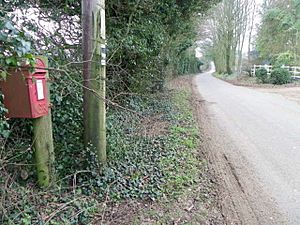Sigwells facts for kids
Sigwells is a small village, also known as a hamlet, in Somerset, England. It is a very old place, full of amazing discoveries from the past. Sigwells sits on a hill overlooking Cadbury Castle, which is a famous ancient hill fort.
Archaeologists have found many important things here. They discovered evidence of people living and working in Sigwells during the Bronze Age and Iron Age. One of the most exciting finds was the oldest known building in Britain where people worked with metal, dating back to the Middle Bronze Age (around 12th century BC). Because of these important discoveries, Sigwells is now a special protected site called a Scheduled Ancient Monument.
Contents
Exploring Sigwells' Past
Sigwells is like a giant puzzle box for archaeologists. It's a flat area of land that looks down on Cadbury Castle. The first digs here were done way back in 1877 by a famous archaeologist named General Augustus Pitt Rivers.
More recently, a project called the South Cadbury Environs Project used special tools to look underground without digging. This is called a geophysical survey. It showed that the area was much more complex than first thought. They found many layers of history from different time periods.
The most important discovery was a building where people made bronze tools and weapons. This building is the oldest of its kind found in Britain! Archaeologists also learned a lot about pottery from the Late Iron Age. They found out that a type of pottery called Dorset Black-burnished ware was traded and used far away from where it was made, much earlier than they thought.
Ancient Burial Mounds and Boundaries
General Pitt Rivers found two types of ancient burial mounds, called barrows, at Sigwells. These were built during the Early Bronze Age. A barrow is a large mound of earth built over a burial site.
Later excavations in 1995 and 2005 looked at one of these barrows again. They found that its circular ditch cut through an even older ditch. This older ditch was part of a system of at least four long, parallel boundaries. These boundaries might be from the Early Bronze Age or even the Neolithic period. This makes them some of the earliest land boundaries ever found in mainland Britain!
The Bronze Age Metalworking Workshop
Archaeologists found an ancient fenced-off area, or enclosure, at Sigwells using the geophysical survey. This enclosure had a rectangular ditch and was connected to one of the older boundary ditches.
When they dug into this area in 1994, they found pieces of clay moulds. These moulds were used to cast metal objects like spears, swords, and axes from the Late Bronze Age.
Further digs between 2000 and 2005 showed that this area was used many times between the 15th and 12th centuries BC. They found a circular building inside the enclosure with a heavily burnt floor. This suggests it was a workshop. Inside and around the building, they found more mould fragments. These fragments were from objects that belonged to a metalworking style called the Wilburton tradition.
One amazing discovery was a mould fragment that fit perfectly with a sword already in the Museum of Somerset. This sword had been found 25 miles away many years ago! Cereal grains found at the site were dated to the 12th century BC. This means the building at Sigwells is the earliest known metalworking site in Britain, even though some bronze objects found elsewhere are much older.
Other items found at Sigwells are now kept in the Eton College museum.
Iron Age Settlements and Fields
By the Middle Iron Age, the Sigwells plateau was covered in a network of small fields and larger areas for animals, called paddocks. These were separated by ditches. A main track with two ditches and smaller paths branched off from it, helping people move around the area.
Archaeologists found signs of several hundred pits and different enclosures that were built and rebuilt over time. This area is one of three large groups of pits found on high ground overlooking Cadbury Castle.
Inside one enclosure, they found animal and human burials, along with Iron Age metal objects. These were found near a rectangular building that might have been a shrine, similar to buildings found on the nearby hill fort. Recent carbon dating suggests that people were active here from the 2nd century BC to the early 1st century AD.
This dating is very important for understanding Iron Age pottery. It shows that Dorset Black-burnished ware (BB1) was being traded far from its production area by about 100 BC. Before this discovery, some researchers thought this pottery didn't reach Somerset until after the Roman conquest of Britain. This new information helps archaeologists understand the timeline of events, including a violent period at Cadbury Castle.
The pits and enclosures at Sigwells were left empty before the Roman conquest. However, another enclosure about 200 meters south might have replaced them during the Late Iron Age. This later enclosure was also abandoned, but it was used again by the 2nd century AD.
Roman-British Life at Sigwells
Later, during the second or third century AD, people built isolated stone buildings at Sigwells. These buildings were connected to the old Iron Age field system, which had been fixed up. This way of arranging settlements was different from other Roman-British farms in Somerset, like those at Catsgore, which were built along a "street."


